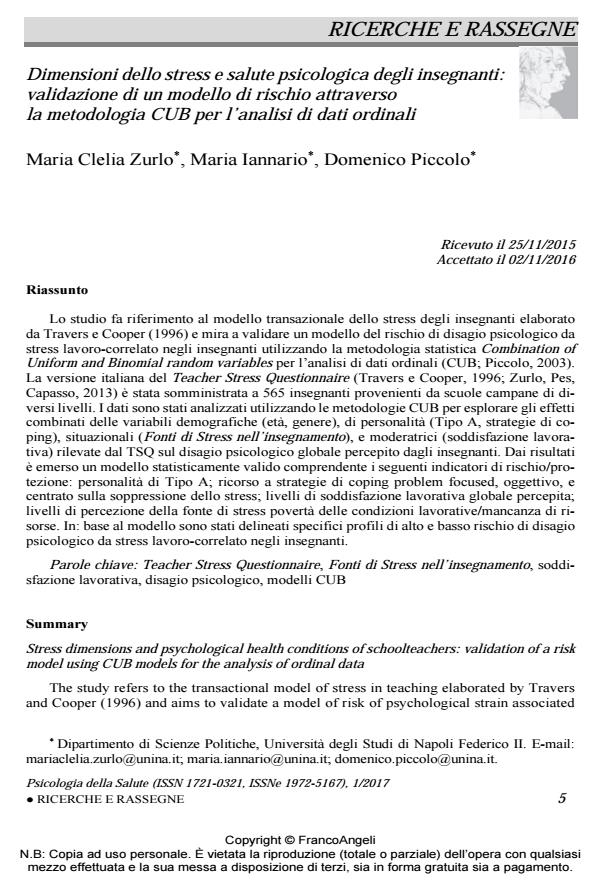Stress dimensions and psychological health conditions of schoolteachers: validation of a risk model using CUB models for the analysis of ordinal data
Journal title PSICOLOGIA DELLA SALUTE
Author/s Maria Clelia Zurlo, Maria Iannario, Domenico Piccolo
Publishing Year 2017 Issue 2017/1
Language Italian Pages 21 P. 5-25 File size 329 KB
DOI 10.3280/PDS2017-001001
DOI is like a bar code for intellectual property: to have more infomation
click here
Below, you can see the article first page
If you want to buy this article in PDF format, you can do it, following the instructions to buy download credits

FrancoAngeli is member of Publishers International Linking Association, Inc (PILA), a not-for-profit association which run the CrossRef service enabling links to and from online scholarly content.
The study refers to the transactional model of stress in teaching elaborated by Travers and Cooper (1996) and aims to validate a model of risk of psychological strain associated to work related stress in teachers through the use of the statistical methodology Combination of Uniform and Binomial random variables for the analysis of ordinal data (CUB, Piccolo, 2003). The Italian version of the Teacher Stress Questionnaire (Travers e Cooper, 1996; Zurlo, Pes e Capasso, 2013) was submitted to 565 teachers randomly drawn from a cross-section of school levels of the Campania Region. Data were treated to CUB Models methodology to analyse the significativity of combined effects of individual and personality factors (age, sex, Type A personality and coping strategies), situational factors (sources of pressure in teaching), and moderator factors (job satisfaction) on self-reported psychological health conditions of teachers The methodology enabled to build a statistically valid model of teacher’s risk for psychological strain associated to work-related stress that includes the following variables: Type A personality; recourse to coping strategies problem-focused, objective, and focused on stress suppression; perceived levels of the source of stress Poor working conditions/Lack of resources; perceived levels of job satisfaction. Profiles of teachers at high and low risk for psychological strain associated to work-related stress are described and commented.
Keywords: Teacher Stress Questionnaire, sources of pressure in teaching, job satisfaction, psychological strain, CUB models
- Teachers’ patterns of management of conflicts with students: A study in five European countries Maria Clelia Zurlo, Federica Vallone, Elena Dell’Aquila, Davide Marocco, in Europe’s Journal of Psychology /2020 pp.112
DOI: 10.5964/ejop.v16i1.1955
Maria Clelia Zurlo, Maria Iannario, Domenico Piccolo, Dimensioni dello stress e salute psicologica degli insegnanti: validazione di un modello di rischio attraverso la metodologia CUB per l’analisi di dati ordinali in "PSICOLOGIA DELLA SALUTE" 1/2017, pp 5-25, DOI: 10.3280/PDS2017-001001